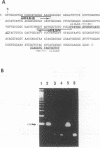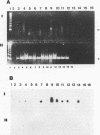Abstract
By using a PCR assay specific for Leishmania braziliensis in blood samples, we detected this parasite in patients cured by immunotherapy or at different stages of treatment. We also found the parasite in subjects who had never suffered leishmaniasis but who had lived in endemic areas and migrated to nonendemic ones many years ago. These results suggest that L. braziliensis infections are difficult to eradicate and that a clinical cure but rarely a complete elimination of the parasite is generally accomplished.
Full text
PDF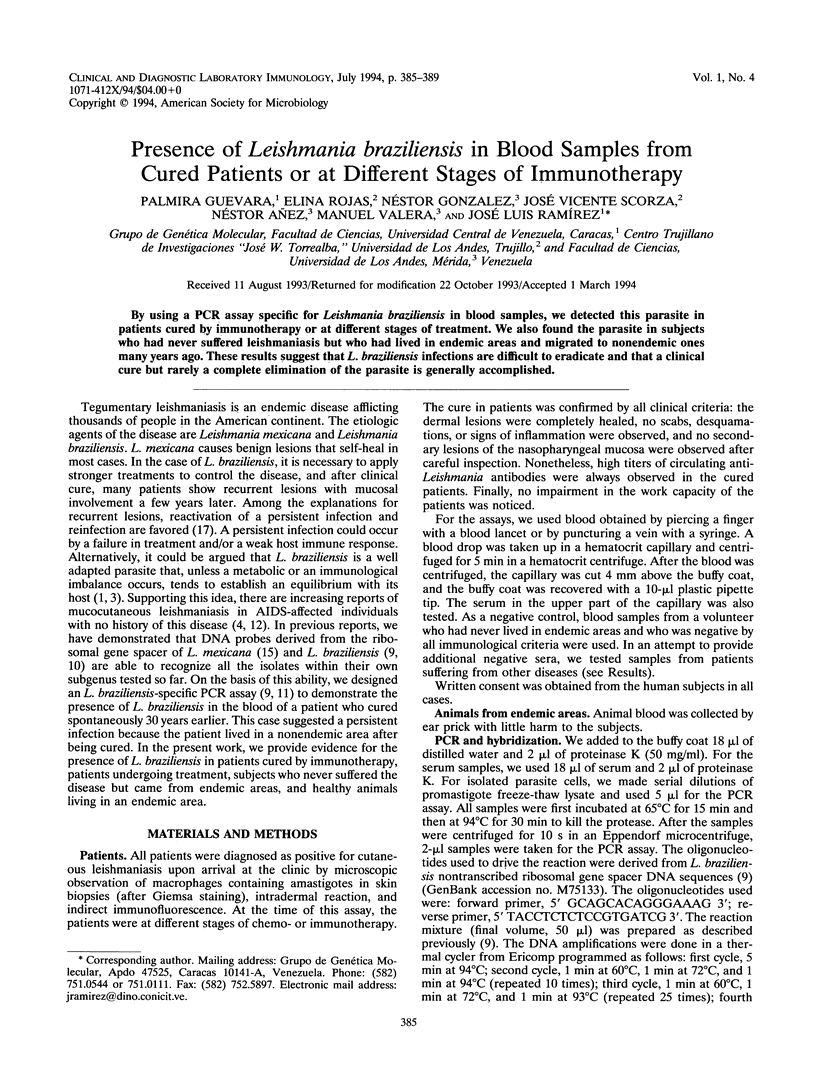

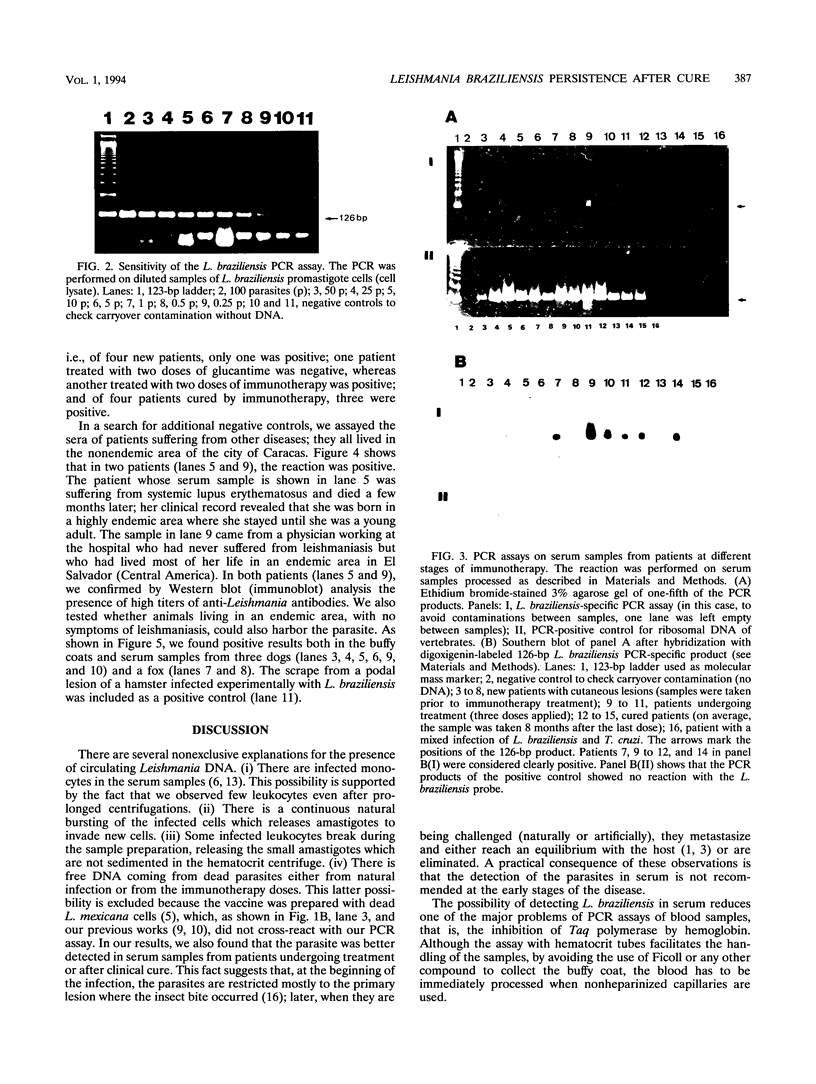
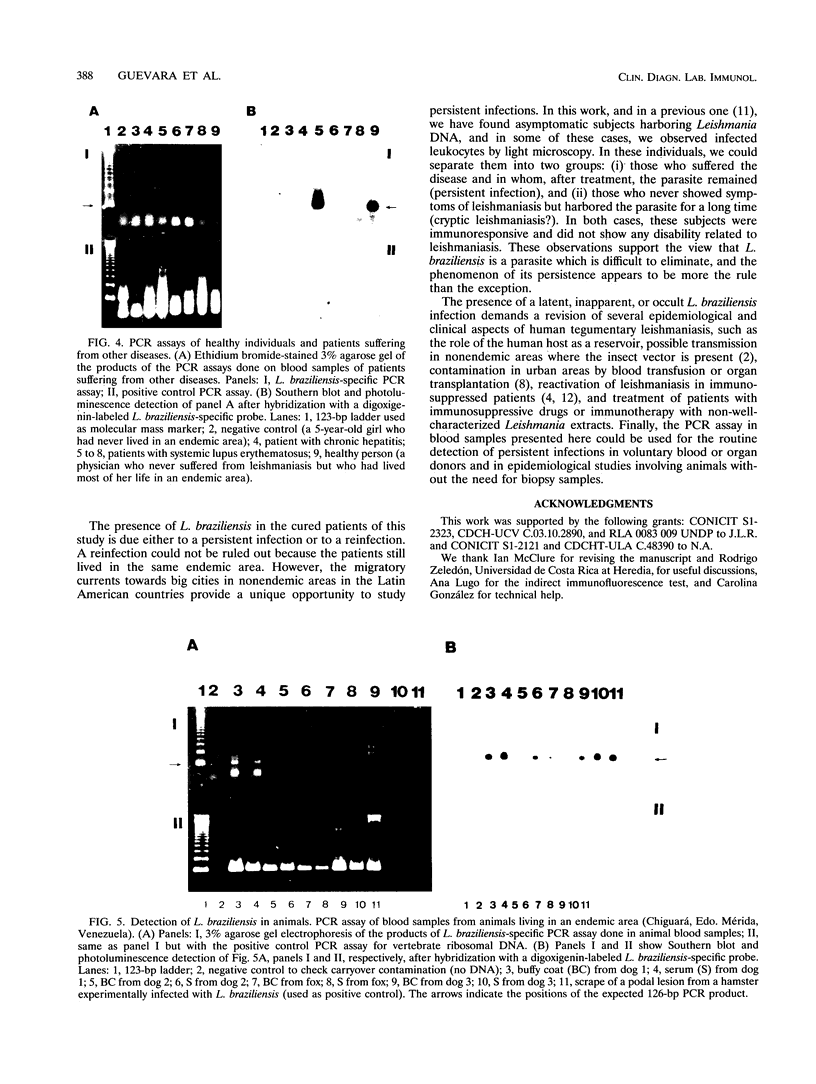
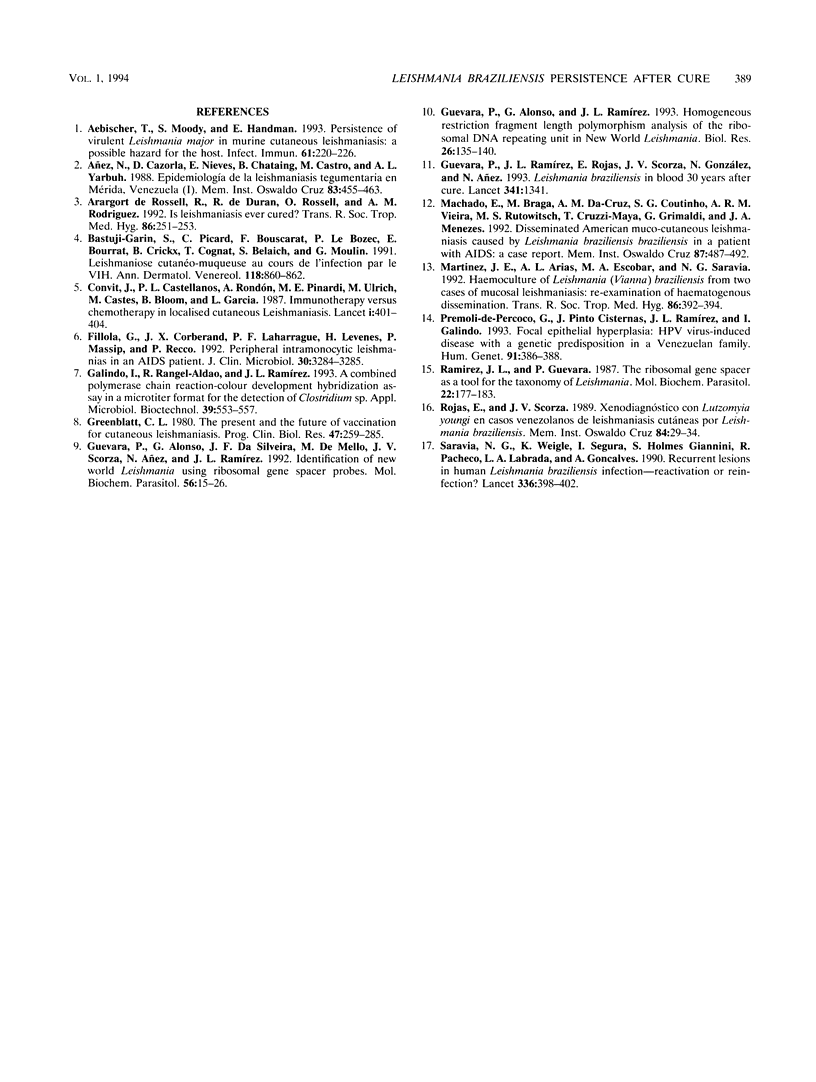
Images in this article
Selected References
These references are in PubMed. This may not be the complete list of references from this article.
- Aebischer T., Moody S. F., Handman E. Persistence of virulent Leishmania major in murine cutaneous leishmaniasis: a possible hazard for the host. Infect Immun. 1993 Jan;61(1):220–226. doi: 10.1128/iai.61.1.220-226.1993. [DOI] [PMC free article] [PubMed] [Google Scholar]
- Añez N., Cazorla D., Nieves E., Chataing B., Castro M., de Yarbuh A. L. Epidemiología de la leishmaniasis tegumentaria en Mérida, Venezuela. I. Diversidad y dispersión de especies flebotominas en tres pisos altitudinales y su posible rôle en la transmissión de la enfermedad. Mem Inst Oswaldo Cruz. 1988 Oct-Dec;83(4):455–463. doi: 10.1590/s0074-02761988000400011. [DOI] [PubMed] [Google Scholar]
- Bastuji-Garin S., Picard C., Bouscarat F., Le Bozec P., Bourrat E., Crickx B., Cognat T., Belaïch S., Moulin G. Leishmaniose cutanéo-muqueuse au cours de l'infection par le VIH. Ann Dermatol Venereol. 1991;118(11):860–862. [PubMed] [Google Scholar]
- Convit J., Castellanos P. L., Rondon A., Pinardi M. E., Ulrich M., Castes M., Bloom B., Garcia L. Immunotherapy versus chemotherapy in localised cutaneous leishmaniasis. Lancet. 1987 Feb 21;1(8530):401–405. doi: 10.1016/s0140-6736(87)90116-4. [DOI] [PubMed] [Google Scholar]
- Fillola G., Corberand J. X., Laharrague P. F., Levenes H., Massip P., Recco P. Peripheral intramonocytic leishmanias in an AIDS patient. J Clin Microbiol. 1992 Dec;30(12):3284–3285. doi: 10.1128/jcm.30.12.3284-3285.1992. [DOI] [PMC free article] [PubMed] [Google Scholar]
- Galindo I., Rangel-Aldao R., Ramírez J. L. A combined polymerase chain reaction-colour development hybridization assay in a microtitre format for the detection of Clostridium spp. Appl Microbiol Biotechnol. 1993 Jul;39(4-5):553–557. doi: 10.1007/BF00205050. [DOI] [PubMed] [Google Scholar]
- Greenblatt C. L. The present and future of vaccination for cutaneous leishmaniasis. Prog Clin Biol Res. 1980;47:259–285. [PubMed] [Google Scholar]
- Guevara P., Alonso G., Ramirez J. L. Homogeneous restriction fragment length polymorphism analysis of the ribosomal DNA repeating unit in New World Leishmania. Biol Res. 1993;26(1-2):135–140. [PubMed] [Google Scholar]
- Guevara P., Alonso G., da Silveira J. F., de Mello M., Scorza J. V., Añez N., Ramírez J. L. Identification of new world Leishmania using ribosomal gene spacer probes. Mol Biochem Parasitol. 1992 Nov;56(1):15–26. doi: 10.1016/0166-6851(92)90150-i. [DOI] [PubMed] [Google Scholar]
- Guevara P., Ramírez J. L., Rojas E., Scorza J. V., González N., Añez N. Leishmania braziliensis in blood 30 years after cure. Lancet. 1993 May 22;341(8856):1341–1341. doi: 10.1016/0140-6736(93)90845-8. [DOI] [PubMed] [Google Scholar]
- Machado E. S., Braga M. da P., Da Cruz A. M., Coutinho S. G., Vieira A. R., Rutowitsch M. S., Cuzzi-Maya T., Grimaldi júnior G., Menezes J. A. Disseminated American muco-cutaneous leishmaniasis caused by Leishmania braziliensis braziliensis in a patient with AIDS: a case report. Mem Inst Oswaldo Cruz. 1992 Oct-Dec;87(4):487–492. doi: 10.1590/s0074-02761992000400005. [DOI] [PubMed] [Google Scholar]
- Martinez J. E., Alba, Arias L., Escobar M. A., Saravia N. G. Haemoculture of Leishmania (Viannia) braziliensis from two cases of mucosal leishmaniasis: re-examination of haematogenous dissemination. Trans R Soc Trop Med Hyg. 1992 Jul-Aug;86(4):392–394. doi: 10.1016/0035-9203(92)90233-3. [DOI] [PubMed] [Google Scholar]
- Premoli-De-Percoco G., Cisternas J. P., Ramírez J. L., Galindo I. Focal epithelial hyperplasia: human-papillomavirus-induced disease with a genetic predisposition in a Venezuelan family. Hum Genet. 1993 May;91(4):386–388. doi: 10.1007/BF00217363. [DOI] [PubMed] [Google Scholar]
- Ramírez J. L., Guevara P. The ribosomal gene spacer as a tool for the taxonomy of Leishmania. Mol Biochem Parasitol. 1987 Jan 15;22(2-3):177–183. doi: 10.1016/0166-6851(87)90048-x. [DOI] [PubMed] [Google Scholar]
- Rojas E., Scorza J. V. Xenodiagnostico con Lutzomyia youngi en casos venezolanos de leishmaniasis cutanea por Leishmania braziliensis. Mem Inst Oswaldo Cruz. 1989 Jan-Mar;84(1):29–34. doi: 10.1590/s0074-02761989000100006. [DOI] [PubMed] [Google Scholar]
- Saravia N. G., Weigle K., Segura I., Giannini S. H., Pacheco R., Labrada L. A., Goncalves A. Recurrent lesions in human Leishmania braziliensis infection--reactivation or reinfection? Lancet. 1990 Aug 18;336(8712):398–402. doi: 10.1016/0140-6736(90)91945-7. [DOI] [PubMed] [Google Scholar]
- de Rossell R. A., de Duran R. J., Rossell O., Rodríguez A. M. Is leishmaniasis ever cured? Trans R Soc Trop Med Hyg. 1992 May-Jun;86(3):251–253. doi: 10.1016/0035-9203(92)90297-p. [DOI] [PubMed] [Google Scholar]



